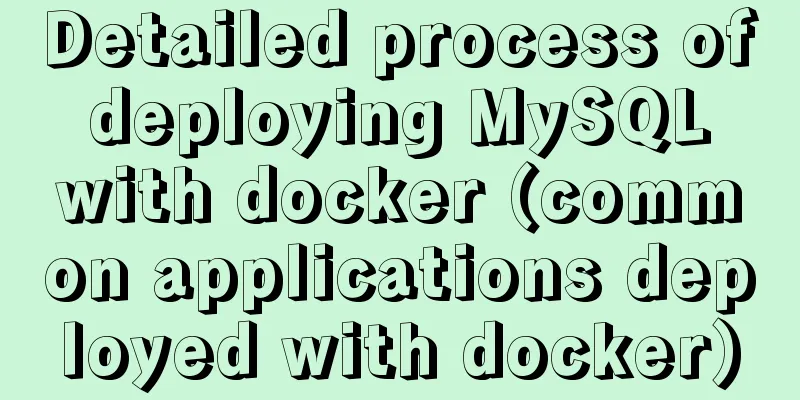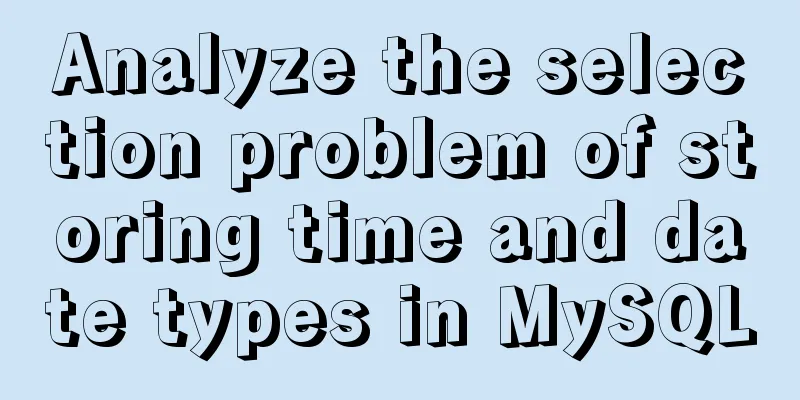Detailed process of deploying MySQL with docker (common applications deployed with docker)

|
I have introduced it to you before: docker (deploy common applications): docker deploy nginx Docker deploys mysql:5.7.26# Download the image docker pull mysql:5.7.26 # View the image docker images|grep mysql # Start the container image. It is recommended to execute the following docker run command under /usr/local/workspace/mysql: docker run -p 13306:3306 --name my-mysql -v $PWD/conf:/etc/mysql -v $PWD/data:/var/lib/mysql -e MYSQL_ROOT_PASSWORD=123456 -d mysql:5.7.26 # It is recommended to hard-code the path docker run -p 13306:3306 --name my-mysql -v /usr/local/workspace/mysql/conf:/etc/mysql -v /usr/local/workspace/mysql/data:/var/lib/mysql -e MYSQL_ROOT_PASSWORD=123456 -d mysql:5.7.26 Command Explanation: -p 13306:3306 maps the container's port 3306 to the host's port 3306 --name my-mysql The container is named my-mysql after startup -v $PWD/conf:/etc/mysql mounts the conf/ directory in the current directory of the host to the /etc/mysql of the container (the conf directory is the configuration file of mysql, it is okay if it is not mounted) -v $PWD/logs:/logs mounts the logs directory under the current directory of the host to the /logs of the container (the logs directory is the log directory of MySQL, and it has no effect if it is not mounted) -v $PWD/data:/var/lib/mysql mounts the data directory in the current directory of the host to the /var/lib/mysql of the container (the data directory is the storage path of the data files configured for mysql. It is recommended to mount it to store data. If the container is shut down, the data can be mounted again.) -e MYSQL_ROOT_PASSWORD=123456 Initialize the root user's password Check the container startup status[xxx@xxx-xx-xxx mysql]# docker ps|grep mysql 5291ed3fe987 mysql:5.7.26 "docker-entrypoint.s?? 5 minutes ago Up 5 minutes 33060/tcp, 0.0.0.0:13306->3306/tcp my-mysql Enter the mysql container# Login container [root@cbov10-sso55-xxx ~]# docker exec -it my-mysql bash root@5291ed3fe987:/# ls bin dev entrypoint.sh home lib64 media opt root sbin sys usr boot docker-entrypoint-initdb.d etc lib logs mnt proc run srv tmp var # Login mysqlroot@5291ed3fe987:/# mysql -uroot -p --default-character-set=utf8 Enter password: Welcome to the MySQL monitor. Commands end with ; or \g. Your MySQL connection id is 2 Server version: 5.7.26 MySQL Community Server (GPL) Copyright (c) 2000, 2019, Oracle and/or its affiliates. All rights reserved. Oracle is a registered trademark of Oracle Corporation and/or its affiliates. Other names may be trademarks of their respective owners. Type 'help;' or '\h' for help. Type '\c' to clear the current input statement. mysql> show databases; +--------------------+ | Database | +--------------------+ | information_schema | |mysql | | performance_schema | |sys| +--------------------+ 4 rows in set (0.00 sec) Set up remote login to mysqlmysql> use mysql Reading table information for completion of table and column names You can turn off this feature to get a quicker startup with -A Database changed mysql> select host,user from user; +-----------+---------------+ | host | user | +-----------+---------------+ | % | root | | localhost | mysql.session | | localhost | mysql.sys | | localhost | root | | localhost | test | +-----------+---------------+ 5 rows in set (0.00 sec) # Set the root user to log in remotely from anywhere and have all operation permissions for all libraries. (The company must not do this because the exposed attack surface is too large.) This is just for testing. mysql> GRANT ALL PRIVILEGES ON *.* TO 'root'@'%' IDENTIFIED BY '123456' WITH GRANT OPTION; Query OK, 0 rows affected, 1 warning (0.00 sec) # Refresh permissionsmysql> FLUSH PRIVILEGES; Query OK, 0 rows affected (0.00 sec) # Exit mysql mysql> exit Bye Regarding MySQL authorization, you can search Baidu by yourself. Here is the recommendation mysql permission management Mysql permission control Remote login testUse the database connection tool to connect to the host IP + the port exposed by the host. When we started the container earlier, -p13306:3306 indicated that the host port 13306 was mapped to the container's port 3306. If our host, that is, the server's IP address is 10.10.10.11 The database connected to 10.10.10.11:13306 should be connected. It is recommended to create a new test database for testing, as follows
Docker, MySQL restart problem (will the data be lost?)# View container [root@cbov10-sso55-113 mysql]# docker ps | grep mysql 5291ed3fe987 mysql:5.7.26 "docker-entrypoint.s?? 4 hours ago Up 4 hours 33060/tcp, 0.0.0.0:13306->3306/tcp my-mysql # Stop the container ( 5291ed3fe987 is the mysql container ID) [root@cbov10-sso55-113 mysql]# docker stop 5291ed3fe987 5291ed3fe987 # Delete container [root@cbov10-sso55-113 mysql]# docker rm 5291ed3fe987 5291ed3fe987 Go to our original mount directory to check
The mount host directory is /usr/local/workspace/mysql, [root@cbov10-sso55-xxx mysql]# cd data/ [root@cbov10-sso55-xxx data]# ls auto.cnf ca.pem client-key.pem ibdata1 ib_logfile1 performance_schema public_key.pem server-key.pem test ca-key.pem client-cert.pem ib_buffer_pool ib_logfile0 mysql private_key.pem server-cert.pem sys The data files are still there! Let's re-execute # Note that the directory must be consistent with the mounted host directory. The command executed in /usr/local/workspace/mysql for the first time should also be in the same directory this time. # Of course, there will be no problem if you write a fixed path [root@cbov10-sso55-xxx mysql]# docker run -p 13306:3306 --name my-mysql -v $PWD/conf:/etc/mysql/conf.d -v $PWD/logs:/logs -v $PWD/data:/var/lib/mysql -e MYSQL_ROOT_PASSWORD=123456 -d mysql:5.7.26 74c91431533ebb9bbfd3a1123b3f910f54770a08ad08c3c37cbbb996d29e0428 # Here we can see that the container id has changed [root@cbov10-sso55-xxx mysql]# docker ps |grep mysql 74c91431533e mysql:5.7.26 "docker-entrypoint.s?? 16 seconds ago Up 15 seconds 33060/tcp, 0.0.0.0:13306->3306/tcp my-mysql # Enter the container [root@cbov10-sso55-xxx mysql]# docker exec -it bash 74c91431533e Error: No such container: bash [root@cbov10-sso55-xxx mysql]# docker exec -it 74c91431533e bash root@74c91431533e:/#mysql -u root -p Enter password: Welcome to the MySQL monitor. Commands end with ; or \g. Your MySQL connection id is 2 Server version: 5.7.26 MySQL Community Server (GPL) Copyright (c) 2000, 2019, Oracle and/or its affiliates. All rights reserved. Oracle is a registered trademark of Oracle Corporation and/or its affiliates. Other names may be trademarks of their respective owners. Type 'help;' or '\h' for help. Type '\c' to clear the current input statement. mysql> show databases; +--------------------+ | Database | +--------------------+ | information_schema | |mysql | | performance_schema | |sys| | test | +--------------------+ 5 rows in set (0.00 sec) Found that the test database is also there! The size of the data file can also be verified before and after the MySQL container is deleted. Readers can try it by themselves. If the host file is saved properly, the data will not be lost. illustrate: In fact, production is much more complicated than this test. It is really difficult to solve the problems of MySQL cluster, master-slave, data synchronization, network, etc. with Docker. The management of MySQL containers or the management of stateful applications requires a more sophisticated tool, the famous Kubernetes project. recommend Docker official website Kubernetes official website This is the end of this article about docker deploying mysql (docker deploying common applications). For more related docker deploying mysql content, please search for previous articles on 123WORDPRESS.COM or continue to browse the following related articles. I hope everyone will support 123WORDPRESS.COM in the future! You may also be interested in:
|
<<: A brief introduction to bionic design in Internet web design
>>: Understanding and example code of Vue default slot
Recommend
How to add default time to a field in MySQL
Date type differences and uses MySQL has five dat...
How to handle concurrent updates of MySQL data
Will UPDATE lock? Will the SQL statement be locke...
CSS syntax for table borders
<br /> CSS syntax for table borders The spec...
The hottest trends in web design UI in 2013 The most popular UI designs
Time flies, and in just six days, 2013 will becom...
Vue form input binding v-model
Table of contents 1.v-model 2. Binding properties...
Ubuntu Server 18.04.5 LTS Server Edition Installation and Configuration Graphic Tutorial
1. Ubuntu Server 18.04.5 LTS system installation ...
Implementation of proxy_pass in nginx reverse proxy
The format is simple: proxy_pass URL; The URL inc...
Detailed explanation of Linux LVM logical volume configuration process (create, increase, reduce, delete, uninstall)
Detailed explanation of Linux LVM logical volume ...
MySQL data table partitioning strategy and advantages and disadvantages analysis
Table of contents Why do we need partitions? Part...
WeChat applet realizes linkage menu
Recently, in order to realize the course design, ...
A problem with MySQL 5.5 deployment
MySQL deployment Currently, the company deploys M...
MySQL join buffer principle
Table of contents 1. MySQL join buffer 2. JoinBuf...
How to use Baidu Map API in vue project
Table of contents 1. Register an account on Baidu...
Optimizing the slow query of MySQL aggregate statistics data
Written in front When we operate the database in ...
Introduction to reactive function toRef function ref function in Vue3
Table of contents Reactive Function usage: toRef ...









![Review of the best web design works in 2012 [Part 1]](/upload/images/67cac325bfd51.webp)

